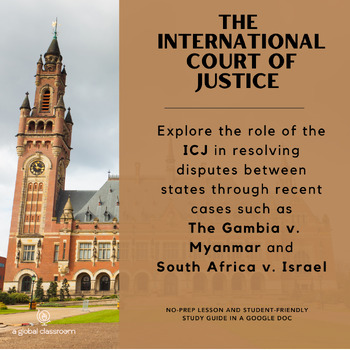The International Court of Justice (ICJ) - IB Global Politics
- PDF
- Google Apps™

Description
Until recently, the International Court of Justice (ICJ) may have been unfamiliar to many students. Often confused with the International Criminal Court (ICC), the ICJ is gaining global attention due to recent events. Following Hamas' attack on October 7th, the ICJ has been thrust into the spotlight, with Israel facing two cases before the court. This is the opportune moment to teach about the ICJ.
This no-prep lesson utilizes the cases of Israel before the ICJ to demonstrate the court's role in resolving international disputes and upholding global laws, while also acknowledging its constraints.
Here is a description of the four learning activities:
1. Warm Up: The lesson starts with a warm up discussion on the kinds of disputes among states and the mechanisms available for their resolution.
2. Backgrounder and Video: The second learning activity consists of a short reading along with two educational videos about the ICJ, followed by comprehension questions to assess understanding.
3. Israel Before the ICJ: The third learning activity prompts students to examine three cases involving Israel before the ICJ.
In the first case, South Africa accused Israel of genocidal acts in Gaza, which Israel denied. The court's preliminary ruling indicated that some of South Africa's claims were plausible, directing Israel to take measures to prevent genocide acts against Palestinians in Gaza. While the court called for humanitarian assistance, it did not demand an immediate ceasefire.
The second case involves investigating if Israel's control of the West bank, Gaza and East Jerusalem since 1967 amounts to apartheid. This case saw over 50 countries participating, marking the largest involvement in the World Court's history. The ICJ is yet to provide its advisory opinion on this matter.
The third case is the 2004 judgment declaring the Construction of a Wall in the Occupied Palestinian Territory as unlawful.
4. Additional Case Studies: Students select one case to investigate. They analyze the dispute, ruling, binding nature, how the case came before the ICJ, and its implications for international law. Options include:
- 2012: “Senegal Told to Prosecute Ex-President of Chad” (Belgium v. Senegal)
- 2021: “Top UN court sides with Somalia in sea border dispute with Kenya” (Somalia v. Kenya)
- 2020: Application of the Convention on the Prevention and Punishment of the Crime of Genocide (The Gambia v. Myanmar)
- 2022: “ICJ orders Uganda to pay $325m for DR Congo occupation” (Uganda v. DR Congo)
- 2023: "Azerbaijan must let ethnic Armenians return to Nagorno-Karabakh" (Armenia v. Azerbaijan)
Finally, the lesson offers diverse perspectives on the court's rulings and cases, drawing insights from various media sources like the New York Times, Aljazeera, Democracy Now!, Reuters, UN News, BBC, the Jerusalem Post, and Haaretz.





